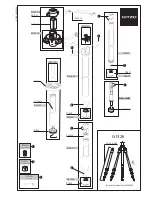
14
4.2.3 How Does the M.L.C.P.C.™ System Function
The Asetek SimSports™ M.L.C.P.C (Mechanical Load Cell
Powered Cylinder) brake cylinder gives you, shy of a full
hydraulic system, an authentic race car driving experience. The
brake cylinder features a load cell sensor (up to 180 kg of pedal
force) detecting actual changes in force on the pedal plate,
which makes it the closest you will come to a realistic brake
experience.
The load-cell ensures accurate and precise measurement in
kilos, and measures force rather than travel. This allows you to
train your muscle memory and subsequently making you faster
on the track. With a hard load cell system, using your muscle
memory is much more reliable than relying on a long travel.
Training your muscle memory will take time, but with training
you will improve, and trust your muscle memory rather than
focusing on the travel in the pedal.
In our effort to achieve a feeling, which gives you the race car
feeling, we have designed a load cell brake cylinder that is
inspired by our hydraulic T.H.O.R.P.™ cylinder.
A hard and short brake pedal is faster because you can brake
later, and it is required to proper trail brake and use your muscle
memory to do so, as explained later. You can consider a race car
braking system as 2 stages:
The “soft stage”:
When you apply pressure on the pedal, it will
move 10-20 mm (measured on the pedal plate), while you build
up hydraulic pressure, while the caliper pistons are traveling to
and pushing the brake pads against the brake disc, and to com-
pensate for the small amount of play in all the mechanical parts
on the pedal system that is required for them not to seize up. At
this stage the car is slowing down but it is soft braking.
The “hard stage”:
When hydraulic pressure is built up, the
brake pads are squeezing the discs hard, and all mechanical play
is compensated. In this stage, your foot is basically “pressing
against a wall”, because now your muscles are pressing directly
against the hydraulic forces (the brake fluid). Since the fluid
cannot be compressed, you will feel the pedal is hard. When a
race car driver complains about a “long” or a “soft” pedal, it is
typically because there is air in the system, and since air CAN
be compressed, the pedal will feel soft and long. The mechanics
then bleed the brakes for air, meaning there is only fluid left in
the system, and the pedal is once again hard after passing the
“soft stage”.
Summary of Contents for SimSports Forte P-BT-2
Page 1: ...1 Sim Racing Pedals Manual ...
Page 44: ...42 ...
















































